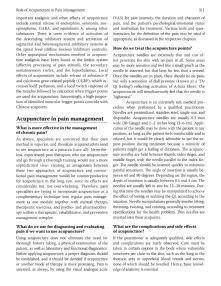Page 323 Guide to Pain Management in Low-Resource Settings
P. 323
Role of Acupuncture in Pain Management 311
important analgesic and other eff ects of acupuncture (VAS) for pain intensity, the duration and character of
include central release of endorphins, serotonin, nor- pain, and the patient’s psychological/emotional status
epinephrine, GABA, and neurokinin A, among other and motivation for treatment. Various tests and ques-
substances. Th ere is some evidence of activation of tionnaires for the defi nition of the pain may be used if
the descending inhibitory system and activation of appropriate, as discussed in the respective chapters.
segmental and heterosegmental inhibitory systems at
the spinal level (diff use noxious inhibitory controls). How do we treat the acupuncture points?
Other supraspinal mechanisms involved in acupunc- Acupuncture needles are extremely thin and can of-
ture analgesia have been found in the limbic system ten penetrate the skin with no pain at all. Some areas
(aff ective processing of pain stimuli), the secondary may be more sensitive and feel like a small pinch as the
somatosensory cortex, and the hypothalamus. Local needle in inserted, but that lasts for less than a second.
eff ects of acupuncture include release of substance P Once the needles are in place, there should be no pain,
and calcitonin gene-related peptide (CGRP), which in- but only a sensation of dull pressure (known as a “De
creases local perfusion, and a local twitch response of Qi feeling”) refl ecting activation of A-beta fi bers. Th e
the muscles followed by relaxation when trigger points acupuncturist will simultaneously feel that the needle is
are used for acupuncture. Interestingly, a high propor- “tightened.”
tion of identifi ed muscular trigger points coincide with Acupuncture is an extremely safe medical pro-
Chinese acupoints. cedure when performed by a qualifi ed practitioner.
Needles are presterilized, stainless steel, single-use, and
Acupuncture in pain management disposable. Acupuncture needles are usually 0.3 mm
wide (30 Gauge) and 1–2 inches long (3–6 cm). Appli-
What is more eff ective in the management cation of the needle may be done with the patient in any
of chronic pain? position, as long as the patient feels comfortable and is
As always, specialists are convinced that their own relaxed, but it would be clearly advisable to use the su-
method is superior, and therefore acupuncturists tend pine position during treatment because a minority of
to see acupuncture as a panacea (cure-all). Neverthe- patients might get a feeling of dizziness. Th e acupunc-
less, experienced pain therapists who use acupuncture ture needles are held between thumb, index fi nger, and
and go through a thorough training would use a more middle fi nger, with the needle parallel to the index fi n-
sophisticated view: creating an antagonism between ger. Th e needle should be inserted quickly to minimize
these two approaches of acupuncture and conven- painful sensations. Th e angle of insertion is usually be-
tional pain management would be counterproductive tween 60 and 90 degrees. Depending on the region, the
for acupuncture in the long run, since its eff ects are depth of insertion is usually between 0.5 and 5 cm. Th e
considerable but not overwhelming. Th erefore, pain needles are usually left in situ for 15–30 minutes. Dur-
specialists are trying to incorporate acupuncture as a ing this time the needles may be manipulated to achieve
complementary technique into regular pain manage- the eff ect of toning or sedating the Qi, according to the
ment as one module together with manual therapy, situation. Needle manipulations generally involve lifting,
therapeutic exercises, and psycho- and pharmacother- thrusting, twisting, and rotating, according to treatment
apy within a therapeutic, rehabilitative, and preventive specifi cations for the health problem. Th in needles are
management complex. inserted into these acupoints.
What do we use for diagnosing and evaluating What are the complications and side eff ects
pain if we want to use acupuncture? of acupuncture?
Using acupuncture does not eliminate the need for If the practitioner is adequately qualifi ed, side eff ects
thorough history taking, a physical examination of the and complications are rarely observed. Care must be
patient, as well as laboratory and functional diagnostics. taken in certain regions in the body where vulnerable
Before applying acupuncture, a proper diagnosis should structures are close to the skin, such as the lung in the
be established, and it should be decided if acupuncture thoracic area or superfi cial blood vessels and nerves,
or another mode of therapy is more promising. Pain is none of which should be needled. Hence, basic knowl-
assessed, as always, by using the visual analogue scale edge of anatomy is essential.


